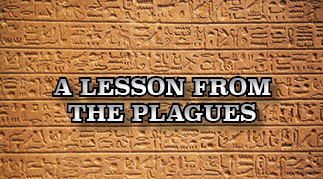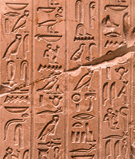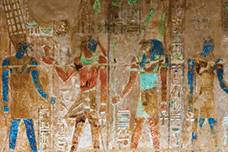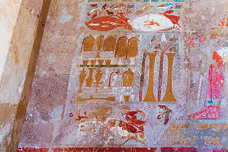
There has been a large number of books and articles attempting to explain what happened and what did not happen as Moses led the nation of Israel out of slavery in Egypt. Some have tried to deny that the Israelites were ever in Egypt, pointing out that Egyptian records make no mention of them. The problem with that argument is that nations give scant details of failures. In modern times, Vietnam has been a demonstration of that fact, getting very little coverage in American history books. Our purpose in this article is not to debate the reality of the Exodus, but to point out some of the hidden messages and to consider skeptic explanations of the plagues.

To start the discussion, we need to understand what the Egyptian religious system was like. The Egyptians had many gods and worshipping those deities varied from time to time. The gods were promoted by magicians and soothsayers who led the people in ritualistic worship and sacrifices. Ten of the dominant gods around the time of Moses were:
- Osiris — god of the dead
- Nu — of the river
- Geb — of earth, creatures
- Ptah — of health
- Shu — of the air, creatures
- Heqet — of fertility
- Hapi — of protection
- Thoth — of learning
- Re (Atom) — of sun, darkness
- Nut — of weather
Let us look briefly at each of the plagues, what Egyptian deity was involved, what skeptic explanations exist, and what problems there are with the skeptic challenges:
PROBLEMS — The Egyptians knew blood when they saw it, and the change was instantaneous and was even in jars and buckets (verse 19).
MESSAGE — The Nile was the life-blood of Egypt, and Nu was a major deity. Nu was incapable of stopping the plague showing God’s superiority over a major Egyptian deity.
SECOND PLAGUE — Frogs: Exodus 8:1 – 15.
PROBLEMS — Dead fish do not push frogs out of the water, and the extreme number of frogs is not explained.
MESSAGE — The Egyptian god Hapi was considered a protector and a controller of all inundations and would never let the Egyptians be overwhelmed. Hapi could not stop the overwhelming numbers.
THIRD AND FOURTH PLAGUES — Insects, lice, mosquitoes, flies only in Egyptian areas: Exodus 8:16 – 32.
PROBLEMS — Biting insects are not limited by political boundaries. Swarms would have moved into Israelite areas.
MESSAGE — Ptah, the god of health, could not stop the bites and their consequences. Heqet, the goddess of fertility could not stop the massive numbers of bugs.
FIFTH PLAGUE — Livestock dies in Egypt, not in Israel: Exodus 9:1 – 7.
PROBLEMS — Diseases are carried by a variety of agents and do not stop at political boundaries. Mad cow and bird diseases are modern examples.
MESSAGE — The Egyptian god Geb was worshiped as the caregiver of all animals that eat from the earth. In spite of elaborate worship and sacrifice by the Egyptians, Geb was helpless.
SIXTH PLAGUE — Boils on human and animals. Magicians and sorcerers are helpless: Exodus 9:8 – 12.
PROBLEMS — A boil has specific characteristics as does anthrax sores. Diagnosis is quite easy.
MESSAGE — Ptah, god of health, is helpless. Thoth, god of learning, has no response.
SEVENTH PLAGUE — Heavy hail ruins barley and flax: Exodus 9:13 – 35.
PROBLEMS — Timing is very unusual. After the barley and flax but before wheat and spelt is not when strong convection systems producing weather would occur.
MESSAGE — Shu fails, and Heqet does not produce.
EIGHTH PLAGUE — Locusts: Exodus 10:1 – 20.
PROBLEMS— The extent of the swarms.
MESSAGE — Nut, Shu, and Heqet all fail
NINTH PLAGUE — Darkness: Exodus 10:21 – 29.
PROBLEMS — The Egyptians knew about this dust storm source, but heavy rains would have stopped any dust storm. Darkness was too absolute to be a dust storm.
MESSAGE — Gods Re and Shu fail.
TENTH PLAGUE — Death of the first born: Exodus 11:1 – 12:36.
PROBLEMS — No possible natural cause
MESSAGE — Osiris is helpless. Re gives no answer.

The message of this listing should be clear. Not only did the plagues decimate the Egyptian economy, medical system, and military system which forced the Exodus, but their religious system was shown to be dysfunctional. This message was critical to the Israelite’s faith in God and provides a message for our times.
Where do the religious systems available today take us? Do they produce peace, provide solutions to natural disasters, motivate people to share resources, promote the equality of all people? Do they advance the welfare of children, respect the role of civil law, promote education and learning among all people? Do they provide a reasonable hope for life after death, and do they free people from the destructive aspects of sin? Jesus said, “by their fruits you will know them” (Matthew 7:16, 20). As the ancient Egyptians were forced to do, it would be wise for us today to look at the products of the various religious systems. This does not mean merely looking at the actions of those who claim to be following a particular system. It means looking at what the system actually teaches and practices. Christianity, as presented in the Bible, works. It has provided unique benefits in every place where the Bible has been followed carefully and literally. Following other religious systems carefully and literally has not produced the benefits seen in the Christian system.

“I am the way the truth and the life. No one comes to the Father except through me” (John 14:6) can be seen in the lesson of the plagues.
Picture credits:
© swisshippo. Image from BigStockPhoto.com
© Gilmanship. Image from BigStockPhoto.com
© Last two photos: Mark52. Images from BigStockPhoto.com
